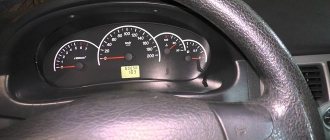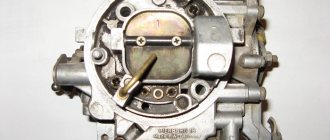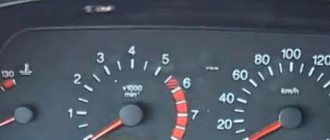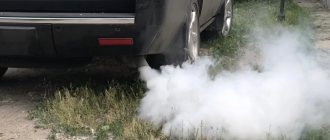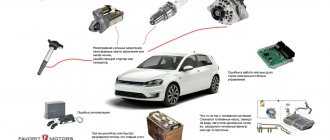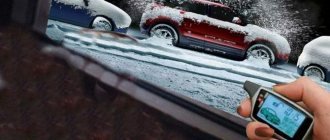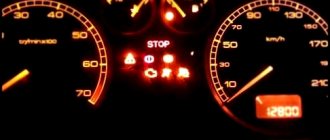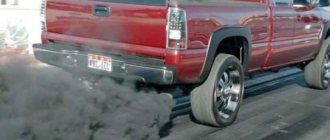From time to time, specialists receive telephone calls asking for information. Often a conversation begins with one question: “Why won’t the diesel engine start?” It is obvious that there is a problem, but with the information that drivers provide, it can sometimes be quite difficult to guess the reason for the complaint.
All that is needed is to have the right amount of heat in the combustion chamber and the right amount of burnt fuel in the old diesel engine being supplied to the combustion chamber at a certain time. This is no different from e-diesels today. By keeping these basics in mind, it would seem that startup problems can be solved. Moreover, a diesel engine may not start only when it is cold or in frosty conditions; in fact, there can be many options. In principle, as well as the reasons.
Looking at the diagnosis, let's discuss the two most basic needs of diesel engine operation: proper heat in the combustion chambers and the right amount of fuel injected at the proper time.
Heating requirement
When asked what creates heat in the combustion chamber, most technicians will answer "proper compression" or "normal glow plug operation." These are great answers, but when faced with this question, you should always start with the correct crank speed. We can move on to compression and proper glow plug function, but without optimal crank speed, engine compression ratio is a moot point.
Most diesel engines require a minimum cranking speed of 150 rpm. If the system is not able to crank the engine fast enough, then you need to do some tests and find out why. Mechanics may have to start by checking the battery, which will include testing the battery, some voltage drop in the negative and positive side of the starter circuits. If all these tests pass, then check the condition of the wiring inside the starter or engine. Unless the engine cranks fast enough, any other test is a waste of valuable time.
Proper compression is also a much-needed part of analyzing a diesel starting problem. There is a time and place for a mechanical compression test, but this test is at the bottom of the diagnostic test list. On a late model diesel engine, access to the compression ratio measurement point may be limited, so there are easier methods.
Video - The engine stalls in winter. Fuel is frozen
Stop and think about engine compression. In the combustion chamber, there are only four places for compression to decrease: through combustion chamber leaks (cracked heads or leaking head gaskets), through the intake valve, through exhaust valve leaks, or through leaks in the piston or piston rings. Experts advise that you can find a compression "leak" by checking the pressure pulses in the intake manifold, exhaust pipe, engine housing or in the engine cooling system.
This process will require the use of a diagnostic sensor (such as FirstLook), but in most cases it will be faster and more reliable than removing certain engine parts and components in an attempt to gain access to the necessary location to obtain an actual compression reading.
Glow plugs
If the engine turns over slowly, this is not a problem; there may be something wrong with the glow plugs. Most passenger cars and light trucks with diesel engines have glow plugs to assist with cold starts. The glow plugs are powered by a relay and timer that sends voltage to the plugs for a set number of seconds. When the timer expires, the relay is supposed to turn off the voltage. But at some point, the relay may become stuck and continue to supply voltage to the glow plugs, causing them to burn. One or two bad glow plugs on a V8 engine may not cause noticeable starting problems in warm weather, but it can happen when temperatures drop.
Check the operation of the glow plugs
Glow plugs can be tested by measuring their resistance or continuity. Excessive resistance or lack of continuity indicates that the spark plug needs to be replaced.
If one or more glow plugs are burnt out, heavily carbonated, or not receiving their normal dose of starting voltage, the engine will become increasingly difficult to start as the temperature drops. If all the glow plugs light up at the end, you'd better check the injection timing because that's probably the cause.
To see if the glow plug module is providing power to the glow plugs, use a voltmeter to test each terminal for the specified voltage while the ignition key is turned on. No voltage? Check glow plug control module connections, ground, and wiring harness. The glow plugs themselves can be tested by measuring their resistance. Replace any spark plugs that you find unsuitable.
Hard starting can sometimes be caused by a glow plug module that doesn't turn on the glow plugs or doesn't keep the glow plugs running long enough when the weather is cold.
Fuel problems
Unlike gasoline, diesel fuel is negatively affected by low temperatures. Fuel consists of heavier hydrocarbons, which turn into wax when the temperature drops. The "cloud point" or point at which wax begins to form for regular summer grade diesel fuel can range from 10 to 40 degrees. If the fuel tank contains summer grade fuel and the ambient temperature drops, wax crystals may form in the water/fuel separator causing a blockage.
Diesel fuel may freeze in low temperatures
The treatment here is to take the car out to a warm garage where it can thaw out. Replace the fuel separator as needed, and then add a "fuel conditioner" additive to the tank (some manufacturers do not approve any additives or prohibit the use of specific ingredients, such as alcohol, that are found in some additives), or drain the tank completely and fill it with Euro 1 fuel, which is higher quality (and more expensive). To prevent this same situation from happening again in the future, you can install a special fuel heater.
Water in fuel is another problem that can lead to performance problems. Condensation that forms during cold weather is a major source of pollution. Water that enters the fuel tank usually settles to the bottom because water and oil do not mix. Water is drawn into the fuel line and goes into the filter or fuel separator. Here it (the filter) can freeze, causing a blockage that stops the flow of fuel to the engine. So if the filter or separator is frozen, the fuel tank must be emptied completely to get rid of the water.
Alternative commentary from a specialist
In 11 years of working at the test site, I have never encountered a car with a turbocharged engine that was equipped with a turbo timer as standard. Apparently, manufacturers believe that with normal operation, the use of high-quality lubricants and fuel, as well as with correct and timely maintenance and repairs, there will be no problems with the turbocharger.
The supercharging unit has a sufficient resource, and its cooling from operating and design temperatures will occur due to inertia. The heat resistance reserve of the materials used is also sufficient.
Did you like this post? Subscribe and you will always be in the know!
Source
December 19, 2022 Category: Useful information.
We have already written about how to make it easier to start a diesel engine in cold weather.
Today we’ll talk about the mistakes that owners make when starting a diesel engine in winter. These errors reduce the life of the unit and can lead to serious and expensive breakdowns. But cold starting is already a difficult test for a diesel engine.
Fuel contamination
Another difference with diesel fuel is that it tastes good to certain microbes, especially if there is water in the tank. Some bacteria can actually thrive inside a diesel car's fuel tank, forming mucus, acids and other creepy stuff that can gum up fuel lines, filters, fuel pumps and injectors. Contaminated fuel often has a "rotten egg" odor and leaves a black or green mark on the inside of fuel system components. The growth rate of most organisms increases at higher temperatures, but some can thrive down to freezing temperatures.
Fuel supply problems
To start and operate properly, the injector's operation must be precise. A quick visual inspection will tell you if the timestamps are lined up correctly. Refer to the vehicle manufacturer's timing procedure if you suspect the timing is off or the pump has been replaced recently. For new diesel engines with electronic injection or direct injection pumps, you need a scan tool to make any changes.
Air in the fuel can also cause a diesel engine to have difficulty starting. The air may cause the engine to stall and subsequent starting attempts will fail. Air can enter the system through any break in the fuel line.
To determine if the problem is airborne, install a clean return hose on the back of the high pressure fuel pump. Start the engine and watch. Air bubbles in the fuel will tell you that there is air in the inlet side of the pump. The high pressure fuel pump itself is usually not the source of the air leak, so check the fuel lines.
Poor fuel quality or problems with its entry into the system
A worn or clogged pump may also be the answer to the question of why your diesel engine won't start. If operating conditions become increasingly worse and this is accompanied by a loss of power, and the mileage is more than 100,000 kilometers, then attention should be paid to the pump, which must be replaced.
Before condemning the pump, you should also check the fuel filters. Dirty filters can cause restrictions in the fuel supply, which prevents the pump from doing its job properly. The separator usually needs to be changed approximately every 50,000 kilometers, and the secondary fuel filter approximately every 30,000 km. New single filter fuel systems typically require maintenance approximately once a year. If the filter has not been given proper attention, it is likely to become clogged.
Diesel won't start
A diesel engine that cranks normally but does not start regardless of outside temperature either has low compression or has a fuel delivery problem. If compression is OK, check the fuel gauges. Next, check the fuel filters and fuel lines for blockages.
If the fuel pump is not pushing fuel through the lines to the injectors, this may indicate a faulty solenoid. Listen for a "clicking" sound inside the pump when the ignition key is turned on. No clicking noise means the pump and/or solenoid needs to be replaced. If it clicks but there is no fuel flowing through the injector tubes (and the filter and lines are not blocked), the pump is likely bad and needs to be replaced.
Injector problems
Diesel injectors can suffer from the same types of problems as gasoline injectors, including varnish deposits, clogging, wear, or leaks. Today's diesel vehicles are fueled with low-sulfur fuel, which can lead to deposits forming on the injectors and reducing the amount of lubrication needed. So you could try using a special additive to help the parts move more smoothly.
Check the condition of the injectors and, if necessary, clean them
Diesel injectors operate at higher pressures than gasoline injectors. Over time, their blood pressure may drop. A pressure level of up to 4.5-5 bar is still considered acceptable, but anything above this value means that the injectors must be replaced. You will need some type of pressure gauge to check the opening pressure of the injectors if you suspect that this kind of problem may be causing the malfunction. Dirty injectors will suck fuel mixture, causing loss of power, rough idling, and sometimes white smoke from the exhaust.
There are several ways to find a faulty injector on a diesel engine. One is to use a digital pyrometer to check the operating temperature of each cylinder. A temperature value that is lower than the others indicates a weak cylinder. If compression is good, the problem is limited to fuel delivery. Another quick method is to use an ohmmeter, which reads tenths of ohms, to measure the resistance of the glow plugs while the engine is running. Plug resistance goes up with temperature, so if one or two cylinders read "low", you've found the problem. For example, if the glow plug normally produces 1.8 to 3.4 ohms on a hot, running engine, then a reading of 1.2 to 1.3 ohms on the glow plugs will tell you that the cylinder is not producing any heat.
How to check the pressure in the fuel system
Diesel exhaust color
Analyzing the color of diesel exhaust may indicate part of the problem. If a diesel engine produces bluish smoke, this indicates that the fuel does not burn quickly. Blue diesel exhaust is caused by fuel evaporating in the exhaust system from contact with heated parts. In the cylinders themselves, it is not possible to completely and evenly burn the mixture of diesel fuel and air.
It is worth noting that during the warm-up process of a diesel engine, white or bluish exhaust is allowed. After the diesel engine reaches operating temperature, this exhaust color indirectly indicates:
- low diesel compression;
- problems with fuel injection pump or injectors;
- late injection advance angle;
- possible malfunction of glow plugs;
- failure of the relay or glow plug control unit;
Black diesel exhaust indicates that the injectors are overfilling with fuel. The second reason why a diesel engine smokes black smoke is insufficient air supply to the cylinders. This indicates problems in the air supply system, and the cause is severe contamination of the diesel engine air filter.
Eliminating white smoke
White smoke usually occurs when there is not enough heat to burn the fuel. Unburned fuel particles exit the exhaust pipe and typically produce a rich fuel odor. It is not uncommon to see white smoke appearing in the exhaust in cold weather until the engine warms up.
As mentioned earlier, bad glow plugs or a faulty glow plug control module can cause white smoke when starting the engine. Low engine speed can also produce white smoke.
Notice the color of the smoke coming from the exhaust system
If white smoke is still visible after the engine has warmed up, it could indicate multiple bad injectors, late injection timing, or a worn high-pressure fuel pump. Low compression can also be a source of white smoke. Be aware of air in the fuel system as it can also cause white smoke.
Filters
As we said earlier, its design is significantly different from its gasoline counterparts. In 60 percent of cases (including Ford cars), diesel engines do not start due to problems in the fuel system. The first thing that could be clogged is the injectors. This is due to poor quality fuel. You cannot clean them yourself - only in a specialized service.
For what other reasons does a diesel engine not start? Of course these are filters. It is necessary to check their condition.
There are two cleaning stages in the fuel system of a diesel engine - coarse and fine.
The latter requires special attention. The filter paper recess through which fuel enters the injectors is capable of trapping particles as small as 10 microns. The resources of this element are 8-10 thousand. km. If you do not follow this recipe, the filter will simply become clogged. As a result, fuel will not enter the combustion chamber, despite the fact that the pump creates the necessary pressure. This can be determined by the nature of the vehicle's movement. If there are gaps in dynamics, it means that fuel is delivered late. And it is delayed by a filter clogged with dirt. It is also worth mentioning the element of air.
Troubleshooting
If a diesel engine stalls at low speeds, this may indicate a lubrication problem in the injector pump. The first thing to check is the idle speed. At low RPM levels, this may prevent the pump from recovering quickly enough during braking to prevent engine stalling.
Water in the fuel can also cause stalling by jamming the metering valve or plungers inside the pump. Using a lubricant additive can help treat this condition. If the additive does not help, the pump may need to be cleaned or replaced.
Video - Why a diesel engine may not start in cold weather
The reason for this phenomenon is that the plunger pair of the high-pressure fuel pump does not work properly. The injection pump must be repaired or replaced. Diesel injector does not work. The main problem with diesel injectors is that they get dirty quickly. Blockage occurs due to the deposition of varnish, sulfur, and mechanical impurities of low-quality fuel. Even if high-quality clean diesel fuel has always been poured, the injectors wear out naturally. Diesel injectors pass through diesel fuel forced by a high-pressure pump. If the passage holes are clogged, the transmitted pressure will be reduced. The permissible minimum pressure after the nozzles should be 300 psi (1 psi = 4.6 atm.). If the value is less than the minimum allowable, then repair or replacement of the injectors is necessary. The performance of diesel injectors is checked on a special stand. Determine the quality of liquid spray.
Faulty injection pump, injectors
Over time, diesel engine injectors become clogged with sediment from fuel impurities, rust particles, etc.
Worn out and dirty injectors do not work as well as they should and do not pump or spray fuel into the combustion chamber. As a result, the diesel engine operates unstably, may stall, and loses its power.
If the diesel engine starts normally in cold weather, but after warming up and reaching operating temperature it refuses, the problem should be looked for in the injection pump plunger pair. The solution is to repair or replace fuel equipment.
The color of the exhaust will also help determine the reason why a diesel engine starts poorly in cold weather and runs unstably.
The exhaust from an efficient car is virtually colorless. But what if the color appeared?
Diesel engine smokes white
White clouds do not always mean that there is something wrong with the vehicle. If they stop appearing some time after you start moving, it's probably nothing to worry about. White smoke is often simply water vapor accumulated in the exhaust system, for example. This is more noticeable at low temperatures.
However, white and dense exhaust gases that leave the system despite long distances are a bad sign. The head gasket or the head itself may be damaged. The white smoke comes from coolant entering the cylinders. We may feel engine vibration or loss of power and notice loss of coolant.
Diesel engine smokes blue
The blue color of the exhaust indicates that the engine is burning oil entering the chambers. Here we may be dealing with several serious defects. The piston rings or cylinder liners may be damaged.
Blue smoke can also be a sign that the valve seals are worn out or the turbocharger has failed.
Diesel engine smokes black
Black smoke clouds are not unusual for diesel engines. They may appear when the engine is started or when the engine is under load.
If black exhaust gases are also visible during quiet driving, and not when the accelerator pedal is pressed hard, this is a signal that the injection system has failed. You may need to replace the fuel pump or the injectors themselves. There is also a possibility that the exhaust gas cleaning system was faulty. Black smoke could be a sign that the turbocharger is damaged or the rubber tubes supplying air to the intercooler are leaking.
Black gas is less common in gasoline engines. In their case, a dark color may indicate problems with the control system of the drive device, for example, as a result of chip tuning that was not fully professionally performed. Fuel is dosed too much.
Diesel engine smokes gray
Gray exhaust gases with a strong odor may indicate that the engine has too rich a fuel/air mixture. Fuel can be dosed in too large quantities, for example due to damage to the temperature sensor.
Causes of poor diesel starting
- Why is it difficult to start when the injector is cold?
- Why is it difficult to start on a cold carburetor?
- Why is it difficult to start on a cold diesel engine?
Reasons why it is difficult to start when cold It is important to distinguish between situations in which problems arise: the car is hot and difficult to start, difficult to start after being idle, when it cools down, (especially in the morning) if it refuses to start in cold weather. They all have their own nuances and reasons that should be considered separately.
We will understand in general terms what reasons lead specifically to poor starting of a cold engine. Usually one or two rotations of the starter armature shaft are enough to start a car in good condition.
If this cannot be done, you need to look for why.
Cold diesel engine won't start in the morning
Also, if a diesel engine does not start when cold, the reason may be a faulty injector. You should check them for the degree of fuel atomization when cranking the starter. If, after checking, you find that fuel is simply pouring out of the injectors, this is probably the reason. As a rule, with this malfunction, the car starts hot, but the engine smokes more than usual. Let's watch the video, airiness of the fuel system as one of the reasons for poor starting of a diesel engine in the morning: Another reason that is not always obvious is engine oil. The fact is that Russian-made diesel fuel contains a significant amount of sulfur, which oxidizes the engine oil much faster. Therefore, it should be changed much more often than indicated in the vehicle registration certificate.
Starter and battery
As the ambient temperature drops, battery performance deteriorates. It may be necessary to charge the battery or check the electrolyte density.
If a diesel engine has difficulty starting when cold, you should make sure that the battery is working properly. It is controlled by turning on the headlights, sound signal or other energy consumers.
The motorist independently determines the failure of the battery or starter. A sign of a breakdown is that the electric starter operates under load and cannot develop normal crankshaft speeds when cold. There are several starter malfunctions in which it operates under load:
- Brush wear. To start the diesel engine, a commutator-type electric motor is used. The voltage is transmitted to the armature through graphite brushes. Their wear leads to poor contact and a decrease in the power performance of the unit. The brushes will need to be replaced with new ones.
- Formation of carbon deposits on the contact pads of the solenoid relay. The contacts allow low voltage to pass through to the motor. This reduces the power of the device. Operation is restored by replacing the contacts of the solenoid relay.
- The brush is stuck in the guide shaft. With prolonged use, dirt accumulates on the inner surfaces of the guide shaft. The graphite element becomes jammed in the guide. After wear, the brush no longer reaches the contact pads. This contributes to poor starting of the diesel engine. To eliminate the malfunction, it is necessary to clean the internal surfaces of the shaft from contamination.
- One of the windings is broken. The rotor rotates under the influence of a magnetic field that occurs when voltage is applied to the working windings. A break in one of them leads to disruption of the magnetic field and deterioration of the unit’s performance. The winding will need to be replaced.
- Bushing wear. The rotor axis rotates freely on soft alloy bushings. Their wear leads to misalignment of the armature. If the bushings are heavily worn, the surfaces of the armature and stator come into contact and the starter operates under load. The repair involves replacing the bushings.
After the diesel engine warms up, the viscosity of the oil in the crankcase decreases and it is easier for the electric starter to rotate the flywheel.
Why doesn't a diesel engine start when cold? - reasons for this phenomenon
There may be a problem with the glow plugs, which perform an important function - heating the working chamber of the cylinder, which contributes to the rapid self-ignition of diesel fuel. But, if the starter clicks but does not turn, then there may be a problem with the electrical or mechanical part of the starter, or the contacts on the battery.
In this case, if you need to charge the battery, you need to know how to properly charge a car battery. The fact is that if the density is greater than 1.27, then the acid separates from the water, and the heating water leads to an explosion of the battery.
Engine oil has thickened
If the oil in the diesel crankcase is too thick or does not have a viscosity coefficient suitable for winter operation, the engine will not start.
Therefore, it is useful to pull out the dipstick and check the condition of the oil and its consistency. If it is viscous and does not flow, you need to change the engine oil.
The battery is discharged, the starter is stuck
The battery copes with extreme loads in winter.
If it is old or its charge level has dropped very much, the crankshaft will not turn at the required frequency to create pressure, and the glow plugs will not warm up to properly heat the fuel.
In winter, it is more difficult for the starter to crank the crankshaft due to engine oil thickening in the cold. If it is worn out, it may jam - it turns, clicks, but does not start the engine.
Club of fans of minibuses and minivans
At high temperatures outside or when the engine is hot, a serviceable diesel engine can be started without glow plugs at all. In severe frost, the purpose of the pre-heating system is not only to facilitate starting, but also to help during the first seconds of warming up. After the “spiral” on the dashboard has died down, the spark plugs continue to work for some time. If you managed to start the internal combustion engine on a frosty morning, albeit off the air, but the engine continues to run unstably for some time, be sure to pay attention to diagnosing the glow plugs.
How to check
- The candle must be turned out of the well;
- connect it directly from the battery (ground to the spark plug body, plus to the bus connection point) and watch it warm up. A working candle necessarily glows from the edge, uniformly changing color as it heats up.
Only such a system will ensure proper starting in cold weather.
Tips and tricks
Some experienced drivers use the following method to make starting a diesel engine easier in winter:
Let us immediately note that this decision is an emergency measure, that is, this method cannot be used regularly. Starting with gasoline vapors leads to increased loads, which significantly reduces engine life.
It is also recommended to insulate the engine compartment and engine separately. A car blanket is well suited for this, as it retains heat and prevents the internal combustion engine from cooling quickly. It would also be a good idea to insulate the radiator of the cooling system. For these purposes, you can use various solutions, the simplest of which is to install a thick cardboard “damper”.
Finally, we note that it is not recommended to warm up a diesel engine for a long time at idle, since this type of engine warms up only when driving under load. This means that after 3-5 minutes of starting work, you need to drive a diesel car, but drive for the first 5 km. should be smooth, without a significant increase in speed, sudden starts and braking, driving in high gears, etc.
Available ways to independently check the glow plugs of a diesel engine. Diagnostics of glow plugs with removal, checking with a tester for spark.
Why is it better to warm up the engine before driving: lubrication, fuel, wear of cold parts. How to properly warm up a diesel engine in winter.
Features of the choice of Webasto and Hydronic preheaters. Characteristics, installation and cost, warranty. Which heater is better?
What is Webasto? Operating principle of autonomous pre-heaters. Pros and cons of a liquid heater and an air heater (hair dryer).
Warming up the engine oil before starting: why is it needed? Available methods of heating oil, what you need to know. Oil pre-heater in the sump.
The main reasons for difficulty starting a hot diesel engine. Problems with the injection pump plunger pair, fuel overflow through diesel injectors, sensors.
Source
Diesel engine does not start well, hot or cold
By the way, this situation can arise regardless of the time of year. It’s just that in the summer, for some reason, many people write it off. Now a little about the breakdown of the injection pump, which is often accompanied by much more serious costs than it actually requires.
It is characterized by difficulty starting the engine during the day, when the car has already covered some mileage, but after it has been turned off, it cannot be started again. Most often, this sign indicates wear and tear of the fuel equipment, and not the engine itself.
The injection pump is a high pressure fuel pump. Of all the fuel equipment, it is this that fails most often. To determine problems with the fuel pump, just pour a couple of liters of cold water on it.
It is necessary to pour exactly on the part where the high-pressure tubes come out and go to the injectors.
Why is diesel difficult to start?
The system includes:
- glow plugs;
- heating relay;
- a bus that connects all spark plugs into a single circuit.
The check should begin with the glow plugs. I can assure you that the popular test method of measuring resistance with a multimeter is a largely ineffective test.
It is designed to detect a rupture of the heating element (in this case there will be no resistance). All spark plugs may have resistance, but they will be the reason for poor starting in cold winter.
Hard to start when cold
However, there may also be a torn membrane in the cold start system, and the valve adjustment also says a lot. To quickly find the cause of poor starting of a cold engine with a carburetor power system, experts recommend checking first: spark plugs, high-voltage wires, carburetor starting device, idle jet, and only then also inspect the breaker contacts, ignition timing, fuel pump operation and the condition of the pipes vacuum booster. Diesel doesn't start well when it's cold. As you know, starting a diesel engine occurs due to temperature and compression, so if there are no problems with the battery and starter, there may be 3 main ways to find the reason why a diesel engine doesn't start well in the morning when it's cold:
- Insufficient compression.
- There is no spark plug glow.
- Fuel supply is missing or interrupted.
One of the reasons that a diesel engine does not start when cold in particular, and poor diesel starting in general, is poor compression. If it doesn’t start in the morning, but seizes from the pushrod, and then there is blue smoke for a certain time, then this is 90% low compression. Blue smoke from diesel exhaust when the starter rotates means that there is fuel supply to the cylinders, but the mixture does not ignite.
Despite the fact that obvious advantages have made diesel engines quite popular, cars with the “heart” of the Diesel cycle remain a rather specific technology. Therefore, it will be useful for every owner of a car running on diesel fuel to find out the malfunctions that cause a diesel engine to start poorly.
Let's look at the reasons why a diesel engine will have trouble starting:
1) on a frosty morning; 2) after a long stay; 3) hot, when the internal combustion engine is warmed up; 4) the starter turns, does not engage, or starts, but then immediately stalls.
The fact that diesel, like gasoline, converts the reciprocating movements of the piston into mechanical work is self-evident. To better understand the reasons for poor starting, let's talk about the specifics of the Diesel cycle.
Motors of this type do not have a coil, distributor, GDP and spark plugs as such. He does not need them, since self-ignition of the fuel mixture occurs in the combustion chambers. The air entering the combustion chamber is compressed by the piston. This causes a significant increase in temperature in the combustion chamber. It is the high temperature of the fuel-air mixture that causes diesel to ignite spontaneously. In cold weather, to facilitate heating of the air in the combustion chamber, all internal combustion engines are equipped with glow plugs.
How to start a diesel engine in cold weather
In order to start a diesel engine at subzero temperatures, it is necessary to approach this procedure comprehensively and perform the following actions:
- As soon as it gets significantly colder outside, it is necessary to fill the fuel tank with winter diesel fuel . If the nearest gas stations have not yet switched to it, then you can add anti-gels or kerosene (preferred) or gasoline (95 or 98) to your summer diesel fuel. The amount of antigel is indicated on the package. As for kerosene or gasoline, it is added 10% of the volume of the fuel tank, decreasing by every 10 degrees Celsius. Please note that you cannot add kerosene to diesel fuel if the car has a modern Common Rail control system.
- Using a clean fuel filter. to change the fuel filter with a new one before the onset of winter . This is especially true for engines with a Common Rail system, since their degree of filtration is higher and is designed for smaller honeycombs in the filter.
- Use motor oil for winter. When choosing, first of all, you need to take into account low-temperature viscosity so that the oil composition is more liquid and does not thicken in cold weather. High temperature viscosity must be taken into account according to the vehicle manufacturer's recommendations. Typically, the instructions indicate that oils of different viscosities can be poured into the engine, so you need to choose a more liquid one from the list. In this case, it is advisable to choose synthetic or semi-synthetic compounds (mineral ones can be used in the summer), since they have more stable performance characteristics and retain their lubricating and protective properties for a longer time.
- Before the onset of cold weather, it is advisable to inspect the fuel system for leaks. In particular, check the clamps and pipes to see if diesel fuel is leaking somewhere. It is advisable to install a transparent tube somewhere in one place in order to see if there are any air bubbles going through it.
- To prevent diesel fuel from draining back into the fuel tank, it is advisable to install a check valve or a small pump that creates a pressure of up to 0.5 atmospheres. With its help, diesel fuel is supplied to the engine without any problems, which makes it easier to start in any conditions. Sometimes, instead of an electric pump, a manual rubber bulb is installed. Modern Common Rail systems do not have this problem, since the pump is located in the fuel tank.
- Check the operation of the glow plugs . This can be done using different methods - without removing them from the engine, using a control light, battery or multimeter. If any spark plug begins to work poorly, it is better to replace it with a new one, preferably at the beginning of winter. In general, it is recommended to change glow plugs approximately once every two seasons, even if they are still in more or less working condition. The only exception may be the warranty period or the mileage of new spark plugs.
- Failure of the glow plug relay . In some cases, the output voltage at the glow plug relay is lower than required. This leads to the fact that these spark plugs do not operate at full capacity, and, accordingly, do not heat diesel fuel well. In addition, modern diesel engines contain “smart” electronics that allow the engine to start only when the diesel fuel reaches a certain temperature. It is easy to check the operation of the relay. To do this, it is enough to use a wire with a large cross-section (4 or 6 square millimeters) to apply voltage directly from the battery to the spark plugs. If the engine starts without problems, you need to change the relay for a new one or make some kind of “homemade” with a similar wire and a button in the cockpit (but with a relay it’s still better, since it’s both automation and protection).
- Low compression . Before the cold season, it is also worth checking the compression. This is done using a compression tester in a garage or using a compression tester or motor tester at service stations. The reasons for low compression may be the following engine elements - wear of piston group parts (piston, rings, cylinder), incorrect adjustment of timing mechanism elements, burnout of valves and/or pistons.
- Check the operation of the starter . It should produce normal (high) rpm. It is advisable to carry out a comprehensive check of both the mechanical and electrical parts (stator/rotor windings, bearings, brushes).
- Charge the battery . During the cold season, you should always monitor the battery charge level, especially if it has been in use for a long time. When the battery is old, it is better to choose the best battery for your car before winter sets in. When choosing, pay attention to the fact that a diesel engine requires a battery with a higher cold cranking current than a gasoline engine. For prevention, it is advisable to remove the battery at night and recharge it from a charger in the garage or at home once a month.
- Check the operation of the generator . Even if a new battery is installed on the car, it is important that it is charged at the normal voltage provided by the generator. That is, you need to check both the operation of the generator itself and check the voltage value supplied to the battery. Usually it is about 14.2...14.5 Volts. The lower the ambient temperature, the higher the voltage should be.
- Check ignition settings . The fact is that some cars work better when the angle is still small, that is, the compression ratio is small. Others, on the contrary, start better when the fuel is supplied with a significant level of compression. Information about this can be found in the vehicle documentation or contact a car service center for help.
- Check the operation of the injectors . Do it yourself in the garage or at home. If the injectors are clogged with deposits, they can also be cleaned in a garage. As a last resort, replace the injectors with new ones. In the latter case, it is better to replace them as a set so that the old injectors do not cause problems compared to the new ones. If the Common Rail injector is leaking, you should check the multi-check valve, or it is better to immediately replace it with a new one.
- Check the fuel heater (if equipped). They operate on the basis of electric heating elements, so you need to check whether electricity from the generator is suitable for them, whether they are intact, and also check the operation of the temperature sensor, which provides information to the electronic control unit about the temperature of the diesel fuel, and accordingly, a command is generated to turn the heater on/off.
When all the parts are more or less in working order, but difficulties arise when starting the diesel engine “cold”, then follow a few simple recommendations:
- During startup, be sure to press the accelerator pedal in order to supply more fuel to the engine. This is especially important during the cold season.
- Starting a diesel engine in winter is made easier by using an external fuel heater. If the standard design of the car does not provide for the installation of the specified heater, then you can install it yourself. Currently, there are three types of such heaters on sale - for the fuel filter, for oil and coolant.
- As a last resort, when the engine does not start, but you still need to drive, you can use the “quick start” tool. The aerosol is sprayed into the intake manifold, after which the probability of starting a diesel engine significantly increases (according to their manufacturers, the probability of starting is about 90%). However, it is necessary to understand that “quick start” products cannot be used on an ongoing basis, and it is not a panacea. That is, it is still necessary to find a breakdown in the engine if it exists and eliminate it.
Conclusion
If you have problems starting or running the engine “cold,” you first need to pay attention to the fuel used, the condition of the fuel filter, the battery charge level, and the viscosity of the engine oil used. Next, it makes sense to check the tightness of the fuel system (lack of air in it), the operation of the glow plugs and injectors. In general, the normal operation of a diesel engine is largely ensured by preventive actions and the use of winter diesel fuel.

